Nematodes in Home Gardens and Landscapes
Fred Warner and Angela Tenney, MSU Plant & Pest Diagnostics
Table of Contents
- Introduction
- Vegetable Gardens
- Small Fruit Plantings
- Herbaceous Perennials, Annual Beddings Plants and Flower Gardens
- Conifers and Deciduous Trees
- Lawns
- Beneficial Nematodes
- Chemical Controls
- Conclusions
- Other Publications
Introduction
Plant-parasitic nematodes are probably the least understood of all the organisms that cause diseases of plants. However, nematodes are the most numerous animals on our planet. It is estimated there are up to 100,000 or more nematodes in a shovel-full of garden soil. The majority of these nematodes are beneficial, indirectly aiding in plant growth. However, some of the nematodes, the plant parasites, can have negative impacts on plant growth and subsequent yields. The purpose of this publication is to provide information on the role of nematodes in home gardens and landscapes.

Nematodes are non-segmented roundworms. This separates them from the segmented roundworms, which are earthworms and their relatives. Nematodes are aquatic animals occurring anywhere water is found including oceans. Adult nematodes range in sizes from about 1/10th of an inch in length to around 100 inches. They are all typically long and thin which is important so the tissues of their bodies can receive oxygen as it diffuses in through their skins (cuticles). The majority of the nematodes found in soil are microscopic, typically less than ½ inch in length. The longer nematodes tend to be parasites of animals, including man. For example, dog heartworm adults are roughly 12 inches in length. If you see worms wiggling on plant roots without magnification, it is very unlikely they are nematodes.
Because the majority of nematodes are microscopic and are never seen by home gardeners, their presence usually goes undetected. Another reason they remain undetected is that feeding by plant-parasitic nematodes typically does not result in any characteristic above-ground symptoms. This explains why these nematodes are frequently referred to as “Hidden Enemies.” One very important consideration when trying to manage nematodes is that it is impossible, in general, to control them unless they are properly identified. To accomplish this, it is necessary to collect samples and send them to a laboratory where nematodes can be extracted from the soil and/or plant tissues, identified and enumerated. In Michigan, this service is provided by Plant & Pest Diagnostics at MSU. Presently, the fee for a basic nematode analysis is $25.00.
Vegetable Gardens
Virtually all vegetable crops are susceptible to root-knot nematodes, Meloidogyne sp. In temperate areas, the northern root-knot nematode, Meloidogyne hapla, is most common. Root-knot nematodes get their name from the primary symptom caused by their feeding which are swellings on the roots of their hosts called galls or knots. Feeding by northern root-knot nematodes typically results in very small galls when compared to those caused by southern species. However, on most vegetables, even these small galls are fairly conspicuous. These galls function as little protective houses for the root-knot nematodes.
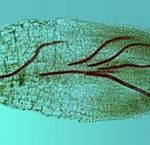
Northern root-knot nematodes overwinter as eggs in the soil. When host plants are sown or transplanted in the spring, their roots quickly come under attack by these nematodes. Young nematodes are attracted to a certain region of the root and often congregate there. This region is an area where the vascular system (the plumbing of the plant) has not yet formed. The nematodes begin feeding in this area and as the root continues to grow and the vascular tissue develops, the nematodes are there to steal the plants’ carbohydrates and disrupt water flow. It is sometimes said that root-knot nematode-infested plants often seem starved for water.
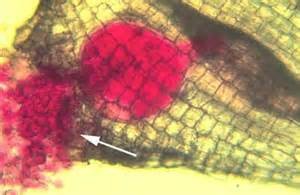
Female root-knot nematodes are prolific egg producers. A single female may produce up to 1,000 eggs and these nematodes will complete multiple generations (egg to adult) over the course of a growing season. Small gardens can quickly become overrun by root-knot nematodes if they are unchecked.
Typically, nematodes by themselves do not kill their hosts. If the host dies, the nematodes often die with it. This is especially true for root-knot nematodes because once they start feeding they are incapable of movement. Root-knot nematodes can regulate their numbers and impacts on their hosts by reversing sex. Male root-knot nematodes do not require nearly as many calories as females and obviously do not produce eggs. If a host is weakened significantly, the nematodes communicate chemically so that females sex-reverse and become males. This eases the burden on the host allowing it to survive which, of course, is beneficial to the nematodes. Usually, if plants die, nematodes are not the sole cause.
Like all species of nematodes in gardens and fields, root-knot nematodes are virtually impossible to eradicate from these environments once introduced. Therefore, steps must to be taken to minimize their impacts. If numbers are high, reducing their population densities is necessary to maximize yields in the garden.
The best management strategy against root-knot nematodes is to avoid them. Of course, this is often easier said than done. Root-knot nematodes will usually be introduced into new habitats within roots of infested plants, so transplants should be inspected for galls and if observed these plants discarded. Typically, if new garden sites were previously in sod, northern root-knot nematodes will probably not be present. However, many weeds are hosts to these nematodes, so areas where native plants, other than grasses, are growing may be infested. To diagnose their presence, collection of a soil sample(s) is required.
To reduce population densities of northern root-knot nematodes, rotation to grasses for 2-4 years is recommended. Since many vegetables, especially carrots are highly susceptible to these pathogens, the longer the rotation the better. Carrot is a crop where root-knot nematodes will affect the quality and quantity produced since it is a root crop. Feeding by these nematodes on carrot may produce extremely stubby, forked or malformed roots and gardeners may be tempted to discard them. For most crops, root-knot nematodes only reduce the pounds of fruit produced. However, maximizing crop yields is not of primary importance to many home gardeners, another reason why nematodes usually go undetected.
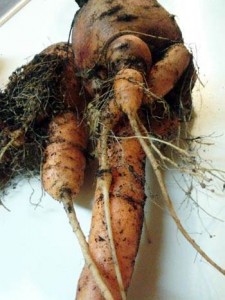
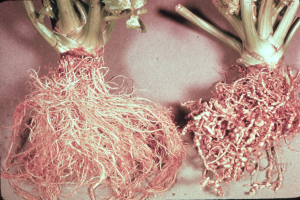
Some cultivars of tomato have resistance to certain species of root-knot nematodes but not to northern root-knots. However, for most vegetables there are no resistant varieties. Another impact of these nematodes is they may render plants susceptible to other pathogens for which they are bred to be resistant. This is termed resistance-breaking and the role of nematodes is well documented in the literature.
Try to keep root-knot nematode-infested plants as healthy as possible. Be sure to fertilize with ample potassium as this element seems to play a key role in alleviating or minimizing symptom expression. Keep plants watered. Try to maintain a healthy soil, one with a high organic matter. The numbers of beneficial nematodes are often higher in soils with high organic matter. As a general observation, when numbers of beneficial nematodes are high, numbers of plant-parasitic nematodes are often low. Try to keep weeds under control.
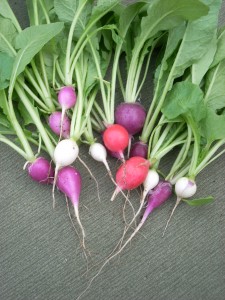
Another control tactic that can be used against northern root-knot nematodes is growing radish as a trap crop. Radish functions as a trap crop as long as they are harvested or killed before the nematodes produce eggs. After root-knot nematodes begin feeding within roots, they swell and are then incapable of movement. If you kill or remove the host, so long nematodes. However, successful use of a trap crop requires close monitoring of the nematodes because it is important to destroy the crop prior to egg production/hatching. If the nematodes are allowed to produce eggs and they hatch, the benefit of the trap crop is lost. In our climate, in cool, moist soils in the spring, it’s best to destroy or harvest the radishes within 30-35 days after planting.
Root-knot nematodes can also be controlled by allowing sections of your garden to lie fallow, using soil solarization or growing crops to be used as biofumigants. Some flowering plants, such as African and French marigolds, are non to very poor hosts for northern root-knot nematodes. It is best to consult us, in MSU Plant and Pest Diagnostics, for specific recommendations.
Vegetables are also susceptible to other types of plant-parasitic nematodes especially lesion nematodes. Please read the information under small fruit plantings for information on lesion nematodes.
Small Fruit Plantings
This section will include the impacts of nematodes on blueberry, grape, raspberry and strawberry. All these plants are susceptible to at least one species of plant-parasitic nematode. In fact, all described plant species have at least one documented nematode parasite.
Strawberry and raspberry are susceptible to lesion nematodes, Pratylenchus sp. In most temperate growing regions, the most common species is P. penetrans. In Michigan, lesion nematodes are the most frequently detected of all the plant-parasitic nematodes.
Lesion nematodes get their name from to the fact they produce microscopic wounds (lesions) on the surfaces of the roots they penetrate. Unlike root-knot nematodes, these nematodes do not swell upon entering the host. They continue to migrate throughout the root feeding and killing cells in the root cortex. They are typically attracted to the smallest feeder roots and in the case of severe infestations these roots are often destroyed resulting in root systems of reduced volumes and weights. Lesion nematode-infested plants often do not compete well for soil nutrients and water. Therefore, the symptoms caused by lesion, as well as many other nematodes, resemble those of nutrient deficiencies.
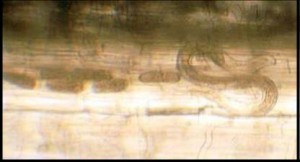
Lesion nematodes overwinter as juveniles (pre-adult life stages) and adults. They prefer to overwinter in roots but also will in soil. They penetrate young roots in the spring and females lay eggs within root tissue. Lesion nematode females do not produce nearly as many eggs as root-knot nematodes. However, similar to root-knots, lesion nematodes can complete multiple generations per growing season with a generation time of roughly one month.
Lesion nematodes can be found in all soil types although similar to other types of plant-parasitic nematodes, sandy soils tend to be nematode-loving soils. They can be found in soils with wide ranges of pH.
The wounds produced by lesion nematodes are often utilized by other plant pathogens to invade plants. Bacteria and fungi need wounds to enter hosts, so lesion nematodes are said to predispose plants to other plant pathogens. Lesion nematodes interact with many soil fungi such as Colletotrichum, Rhizoctonia and Verticillium, the latter two are important pathogens of particularly strawberry. With these interactions, the combined impacts of the two pathogens can significantly reduce plant growth and yields.
Strawberries are extremely sensitive to lesion nematodes. They often interact with Rhizoctonia to cause black root rot of strawberry. If strawberries are purchased from a nursery infested with Rhizoctonia and planted into a site with lesion nematodes, these plants will suffer in productivity. When examining strawberry roots, healthy roots are typically white. If they are black, this may be indicative of black root rot.
Raspberry is also susceptible to lesion nematodes. Steps should be taken to avoid planting raspberries in a location where Verticillium dahliae (a wilt-causing fungus) may be present as lesion nematodes can predispose plants to this fungus. The interaction of these two organisms will shorten the life of raspberry plantings.
Blueberries are grown in low pH, high organic soils and although lesion nematodes can be found in these environments, blueberry is documented as a non- to poor host for our most common species, P. penetrans. However, lesion nematodes can stunt the growth of blueberry in other parts of the US where highbush blueberries are grown.
Grapes are hosts for lesion as well as many other types of plant-parasitic nematodes. Historically, Michigan was a juice grape state but more and more acres are going into wine grape varieties. The impacts of nematodes on many of these cultivars in Michigan are largely undetermined. Research done in the 1990s indicated many French/American hybrids were susceptible to northern root-knot nematodes. The presence of dagger and or needle nematodes on sites where vineyards will be established is always a concern because these nematodes are notorious vectors of some plant viruses. It is highly recommended that potential vineyard sites are sampled for nematodes in an attempt to avoid future problems. There are no post-plant chemical control options for nematodes on grapes even for commercial growers never mind for homeowners or hobby wine makers. More detailed information on dagger nematodes is provided below.
Lesion nematodes are very difficult to control using crop rotation as most plants grown in gardens are hosts. Clean fallow will reduce population densities. Pearl millet is a very poor host. If you enjoy bird watching, this may make pearl millet even a more attractive option. Biofumigation/soil solarization is another potential control option.
Because lesion nematodes are so common in MI, avoiding them is virtually impossible. Most plants will tolerate some feeding from lesion nematodes, so minimizing the impacts of other pathogens is an important management tactic.
All fruit are susceptible to dagger nematodes, Xiphinema sp. Dagger nematodes are nematodes that feed with their bodies outside of the root and they use their stylets (similar to hypodermic needles, all plant-parasitic nematodes possess stylets) to puncture cells. Dagger nematodes have fairly long life cycles and adults can survive for over a year. They do not produce large numbers of eggs. They prefer sandy soils. Dagger nematodes are pathogens of plants but the primary concern is their abilities to vector certain plant viruses. Only one dagger nematode is required to acquire a virus from a diseased plant and transmit it to a healthy one.
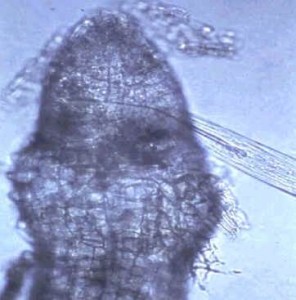
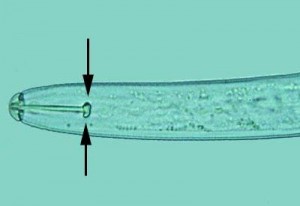
All fruit, small and tree, are susceptible to at least one virus transmitted by the American dagger nematode, X. americanum. Two of the most common viruses transmitted by these nematodes are tobacco and tomato ringspot viruses. Blueberry and raspberry are susceptible. Infected plants will be severely stunted and produce very low yields. Grape is sensitive to peach rosette mosaic virus, also spread by dagger nematodes. Typically, these viruses are only spread by dagger nematodes.
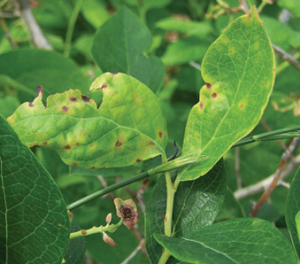
Positive detection of viruses is critical to minimize the impacts of these nematodes. Rogue out and destroy virus-infected plants. Efforts should be made to remove as many roots as possible. Soil in these areas should be churned regularly. If this is not feasible, plant a grass for two years and be sure to control weeds. Many broad-leafed weeds, especially dandelion will harbor these viruses, so good weed control is critical. Grasses can host dagger nematodes but they are not hosts for these viruses. Since viruses must be acquired by dagger nematodes through feeding, eliminating the sources/carriers of viruses is a good management tactic. Female dagger nematodes, even if they possess viruses, cannot pass them onto their offspring through eggs. In the end, if dagger nematodes are present in any given location, purchasing virus-free planting stock and controlling broad-leafed weeds are imperative.
Dagger nematodes are more frequently encountered in perennial cropping systems than annual ones because they are sensitive to soil disturbance. Regular cultivation will reduce population densities of these nematodes. They do not like dry, hot soils, so frequent churning of the soil should provide good control.
Rape can also be used to control dagger nematodes but it can become a weed if allowed to go to seed. If rape is grown, plow it down as a green manure prior to flowering.
Herbaceous Perennials, Annual Beddings Plants and Flower Gardens
This section encompasses many plants species and cultivars thus providing a tremendous amount of genetic diversity. Plants in this section are susceptible to northern root-knot and lesion nematodes and information on those two parasites has already been provided. Lesion and root-knot nematodes are typical of most plant-parasitic nematodes in that they feed on cells located within the roots. However, there are a small number of nematodes that occur in the foliage.
Two species of foliar (leaf) nematodes, Aphelenchoides fragariae, and A. ritzema-bosi are often detected in temperate growing regions. Both these species have wide host ranges but A. fragariae is often associated with Begonia, ferns, Lilium, strawberry, and violets whereas, A. ritzema-bosi is more common on other plants. In general, foliar nematodes are a more significant problem in green or poly houses than outdoors mainly because they don’t survive readily over the winter unless host foliage or weed hosts are available.
Foliar nematode feeding results in leaf blotches because of tissue death. The form and pattern of these blotches vary from plant species to species and is closely correlated to leaf anatomy and venation. In most dicotyledonous hosts, leaves are rather thin, so the main veins subdivide them into areas with little or no continuity of intercellular spaces between them. Thus, the veins act as barriers to nematode movement. The nematodes reach other sections of a leaf by emerging from stomata (openings in leaves where gases are exchanged) and migrating over the surface in water film. The result is a leaf with discrete areas showing different stages of discoloration. In some plants with thicker, fleshier leaves such as Begonia or Cyclamen, the veins do not act as barriers resulting in irregular areas of discoloration with poorly defined margins. Because foliar nematodes typically crawl from the soil onto stems, lower leaves are the first to exhibit symptoms. Often these leaves, when they die, will cling to the stems.
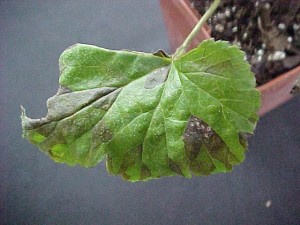
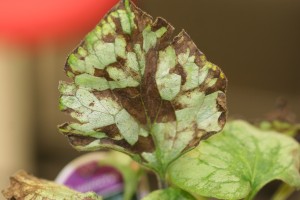
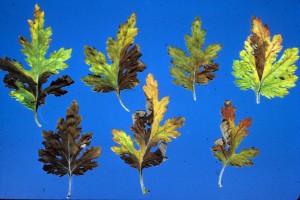
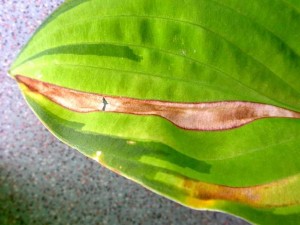
Foliar nematodes have relatively short life cycles going from egg to adult in approximately 2 weeks. Females can produce large numbers of eggs, so symptoms can occur and spread fairly rapidly.
Try to purchase plants free of foliar nematodes symptoms. There are no post-plant chemical control options, so infested plants should be removed from the garden and destroyed. To reduce the spread of foliar nematodes, try to minimize leaf to leaf contact of susceptible plant species like Anemone and Hosta and reduce overhead irrigation which can spread the nematodes in splashing water. Good air flow around plants is advantageous as this will result in faster drying of leaf surfaces. Sanitation is highly beneficial. Always try to remove as much old, dead leaf material as possible as these are preferred overwintering sites. Good weed control is imperative.
Stem nematodes, Ditylenchus sp., also feed on leaf tissues. D. dipsaci is the most commonly encountered species of stem nematodes in temperate climates. It has a very wide host range but is most associated with plants propagated as bulbs, corms or tubers. Like with foliar nematodes, woody plants are not often attacked by stem nematodes.
These nematodes overwinter as fourth-stage juveniles and adults in plant tissues or the soil. When moisture is adequate, the nematodes migrate from their overwintering sites onto the stems and leaves of young plants. Maximum activity of these nematodes coincides with the principal growing periods of most hosts, especially annual ones. Females can produce up to 500 eggs and live 10 weeks or longer. The life cycle can be completed in about 21 days in optimal conditions. These nematodes are very active early in the spring and egg laying can commence at temperatures less than 400 F. Cool, wet springs favor stem nematodes although symptoms of their feeding may not become evident until the summer.
Stem nematodes can persist for long periods of time. They are quite resistant to desiccation and cold temperatures. These nematodes will often form aggregates of large numbers of individuals (sometimes called “eelworm wool”) to survive during adverse conditions. Even in a dried state, these nematodes will become active very quickly in water. Therefore, populations will decline in fields in the absence of host plants due to rewetting and drying out of old plant tissue and soil.
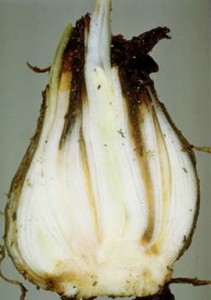
The symptoms caused by D. dipsaci infections vary depending on the plant species attacked. Narcissi and tulips are very susceptible to these nematodes but the symptoms differ on these two hosts. On narcissus, the typical symptom is the presence of pale-yellowish, blister-like swellings on the leaves called spickels and concentric brown rings when the bulbs are cut open (transverse section). The spickels are best seen before flowering when the leaves are actively growing. If the nematodes are present at low population densities, it may be easier to feel the spickels than see them.
On tulips, infestations are best detected at flowering. The initial symptom is a pale or purplish lesion on one side of the stem immediately below the flower which bends in the direction of the lesion. These bulbs do not show brown rings as with narcissus, hyacinth or Allium when cut across. Infestations start at the base of new bulbs. Upon removal of the outer brown scale, soft grayish or brownish patches can be observed on the outer fleshy scale. Garlic is a host to D. dipsaci and on bulbs, it is often difficult to diagnose their presence. Cloves should not be planted if infested with these nematodes. Because of its wide host range, it is difficult to rotate away from D. dipsaci. On garlic and onions, this pathogen is often referred to as the “bloat nematode.”
D. dipsaci also parasitizes many herbaceous perennials and one frequently attacked is creeping phlox, Phlox subulata. Infested shoots are typically thickened and brittle, with shortened internodes and a tendency to split. Severely infested plants often have a hollow appearance like they are being eaten “from the inside out.” Rhizoctonia may interact with stem nematodes on creeping phlox increasing the severity of the symptoms.
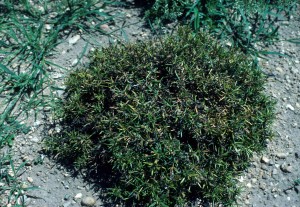
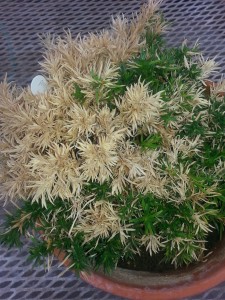
Like with other nematodes, steps should be taken to avoid stem nematodes. Avoid planting bulbs, corms or tubers that may be infested with these nematodes. Try to purchase these items from reputable nurseries. This advice is also pertinent when purchasing herbaceous perennials especially creeping phlox. If the plants look unhealthy in flats or pots at the nursery or garden center, chances are they will remain that way when planted into the home landscape.
It is best to rogue out any plants that exhibit symptoms due to stem nematodes. As with other plant-parasitic nematodes, it is necessary to have plant tissue tested to obtain positive diagnoses of their presence. It should be noted that both foliar and stem nematodes are quite difficult to diagnose in soil samples.
For other cultural tactics used to control stem nematodes such as plant spacing, watering, etc., see the information on foliar nematodes. It is also important to note that many weeds also serve as hosts to stem nematodes, so good weed control is important.
Conifers and Deciduous Trees
In general, trees long established in landscapes should tolerate feeding by plant-parasitic nematodes quite well. However, seedlings are susceptible to injury if planted in areas with high levels of nematodes. Many of the nematodes already covered, such as root-knot, lesion, and dagger, are potentially serious pathogens of young trees. Other nematodes such as needle and ring also can stunt the growth of seedlings. Always try to keep young trees fertilized and watered as optimally as possible. Nematode problems on seedlings tend to be more of a problem in nurseries than for homeowners. But, if roots have been invaded by nematodes at the nursery and you purchase these infected trees, you are bringing home unwanted guests and they may even negatively impact other plants in your landscape.
Fruit trees, both pome and stone, are susceptible to the same nematodes and viruses as were listed under the section on small fruit plantings. In home environments, feeding by nematodes alone probably will not result in the development of conspicuous symptoms and yield losses although they can potentially occur. However, the viruses transmitted by dagger nematodes are extremely debilitating and will shorten tree life drastically. If you suspect any trees are infected with a virus, tissue must be collected and assayed. Some virus testing can be done in our lab at MSU but often samples for viruses must be sent to another facility. We use Agdia located in Elkhart, IN. Virus testing can be expensive, so check their website for pricing options.
Pine wilt is a disease of mature pine trees. It is caused by the pinewood nematode, Bursaphelenchus xylophilus, and largely affects exotic pines. In Michigan, the most susceptible pines are Austrian and scotch although the nematode has also been detected in native pines. Pinewood nematodes have also been recovered from other evergreens such as cedar, balsam fir, larch, and spruce. Infections by pinewood nematode cannot be cured and the nematode is typically found in trees at least 15-20 years old.
Pinewood nematodes are carried from tree to tree by long-horned beetles. They exit the beetle while it is feeding and enter the resin canals of the trees through the beetle’s feeding wounds. The nematodes quickly move within the tree. Although often only one or two branches may initially exhibit symptoms, infected trees often quickly succumb, a few months after the symptoms are initially observed. These dead and dying trees are very attractive to beetles presenting the nematodes opportunities to hitch more rides. It is an insect-nematode partnership.
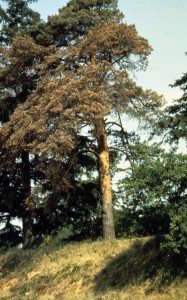
Diagnosis of pine wilt involves collecting wood and sending it to a nematode diagnostic laboratory. Infected or dead trees should be removed from landscapes and destroyed as quickly as possible because they act as reservoirs for the nematodes and beetles. A geographical or neighborhood approach of education and awareness is critical to reducing the risk of future infestations. Pine wilt typically seems to be a problem of urban areas possibly because more exotic pines are planted in landscapes.
To learn more about pine wilt, please visit The American Phytopathological Society lesson on Pine Wilt Disease. The disease is quite widespread in Michigan and other North Central States. This disease is a significant problem of forest trees in China, Japan, and Korea.
Lawns
The species of grasses typically used for home lawns, Kentucky bluegrass, perennial ryegrass, and fescues are hosts to at least 10 different types of plant-parasitic nematodes. In general, these grasses tend to tolerate feeding by plant-parasitic nematodes fairly well. However, under adverse growing conditions, symptoms due to nematode feeding can become evident. Nematodes that feed on turfgrasses are largely ignored by homeowners.
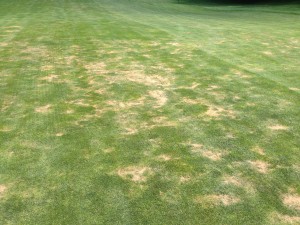
Feeding by plant-parasitic nematodes will result in patchy lawns of uneven growth. Since nematodes generally feed within or on roots, the primary symptoms caused by this feeding (lesions on roots, reduced root systems) are never observed. Infected plants may produce fewer blades (leaves) so the turf can appear thin. This can lead to other problems most notably weed infestations, because the best defense against weeds in home lawns is dense, actively-growing turf.
Homeowners should try to keep lawns as vigorous as possible and attempts should always be made to promote good root growth. Make sure to fertilize at least one time per year, preferably in the fall, with ample potassium. Watering is critical during the summer months. Since plant-parasitic nematodes reduce root volumes and weights, water will aid in root growth. Soil aeration is also a good way to improve or maintain good root health. Aeration, as the name implies, allows more oxygen to reach the roots but also may help drainage if compaction is an issue. Lawns should be aerated once per year.
There are no chemical control options for nematodes in home lawns. It is important to remember that nematodes are always present. There will be no mass migrations of nematodes into a lawn but their numbers will fluctuate. One year, depending upon environmental conditions, symptoms may not be apparent but may be the following year. If you attempt to diagnose problems associated with your lawn and have exhausted almost all potential causes, it could be nematodes.
Beneficial Nematodes
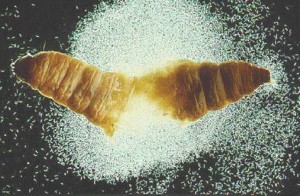
Upon perusing trade journals, advertisements or articles on entomophagous (entomophilic) nematodes may be observed. These are a group of nematodes that can provide biological control of many insect species especially those found in the soil. Typically, it is recommended that these nematodes be applied at rates of 2-4 billion per acre quite often for control of grubs although they are often used in greenhouses to control fungus gnat and shore fly larvae. Although they are nematodes, these nematodes are not parasites of plants and will not harm vertebrates. In certain situations, they have been demonstrated to provide good to excellent control of some species of insects.
This publication has focused mainly on “bad” nematodes but usually, the majority of nematodes in the soil are beneficial. The beneficial or “good” nematodes feed on bacteria, fungi, other nematodes, and microorganisms and can parasitize insects and other arthropods. Plants typically grow much better in the presence of these good nematodes.
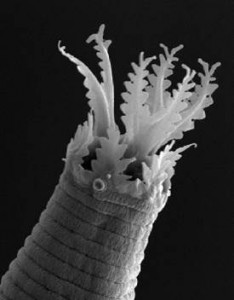
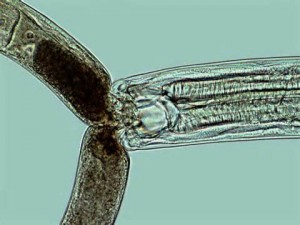
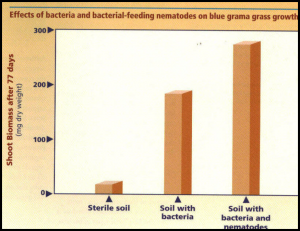
As roots grow in the soil, their surfaces are colonized by bacteria and fungi. The bacterial-feeding nematodes consume some of the bacteria and, as all animals do, eventually pass off the unassimilated food as waste. In the case of these nematodes, this waste is typically high in nitrogen and can be in the form of ammonia. Ammonia is a very good compound for fertilizing plants so essentially these nematodes are providing food right on the surfaces of the roots where it is readily available. This is one explanation of why plants grow better in the presence of beneficial nematodes.
Beneficial nematodes are usually more abundant in soils with high organic matter being of animal or plant origin. The greatest amount of biological activity and diversity is in the “O” horizon of soils (the organic matter usually found on the surface). In general, as you move deeper into the soil, there are fewer biological organisms. The soil is essentially a living entity. Plant-parasitic nematodes often do not become serious problems in home gardens due to the sustainable types of practices gardeners use.
We provide a service at MSU where we will count the numbers of beneficial nematodes recovered from a soil sample. On the submittal form, which can be printed from our website, please circle “Nematode Trophic Composition” found in the middle of the form. There is an additional fee for this analysis but if you are interested in building as healthy a soil as possible, you may want to gather data on the numbers of these beneficial nematodes in your garden(s) since nematodes are recognized as being good indicators of soil health.
Chemical Controls
There has been little or no mention of chemical controls in this article for nematodes in home gardens. Most nematicides (chemicals that kill nematodes) are restricted use pesticides, therefore, you must have pesticide certification training to purchase and apply them. Nematicides tend to be some of the most toxic pesticides available. Effective nematicides usually possess one or both of two properties, being either highly toxic or persistent for long periods of time in the soil. In addition, most are carcinogens and are environmental and human health risks.
There are some products that can be purchased by homeowners. Before using them, you should ask a Nematologist about their effectiveness. In general, if you maintain healthy soils, use of any of these products should not be necessary as the impacts of plant-parasitic nematodes should be insignificant.
Conclusions
The goal of this publication was to increase awareness and knowledge of home gardeners about nematodes. Home garden sites can become infested with nematodes and the problems never properly diagnosed. Aesthetics and yields of plants can be compromised due to the presence of many nematodes. Often this leads to frustration as home gardeners struggle to grow healthy plants.
If you think you might be experiencing problems with plant-parasitic nematodes, don’t hesitate to contact us at Plant & Pest Diagnostics at MSU. Here we have a knowledgeable entomologist (insects and other arthropods), nematologist(s), and plant pathologist(s) (bacteria, fungi, etc.) on staff. We can probably answer most questions or address concerns that arise in plant propagation.
Other Publications
Consult web sites for additional information on plant-parasitic or other types of nematodes. Many nematologists or diagnostic labs provide information as fact sheets, extension bulletins, short articles, etc. on their web sites. Please consult http://pestid.msu.edu, the web site for Plant & Pest Diagnostics at Michigan State University, for fact sheets on selected nematodes and other problems encountered by home gardeners. Another good site for information is MSU’s Extension site, http://www.msue.anr.msu.edu. Articles written by county educators and MSU specialists can be found under new topics and there is a lawn and garden category. We would also be remiss to mention that there is actually a Society of Nematologists and more information can be found at http://www.nematologists.org.
Acknowledgments
Special thanks to Lee Duynslager for his assistance with the formatting of this document and to Dr. George Bird, Nematologist at MSU, for providing many of the images. Thanks to others whose photos were used and apologies to any not properly credited.



 Print
Print Email
Email




